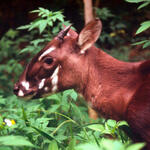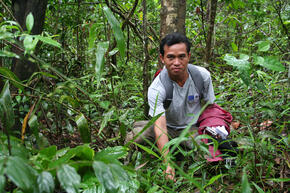The Final Frontier
With three of the most pristine large rivers and some of the most extensive intact forest in the region, Myanmar is one of the most biologically diverse and ecologically productive nations on Earth. Its rich natural assets form the foundation for Myanmar’s long-term sustainable development. In recent decades Myanmar has witnessed its neighbors over-exploit their natural wealth, from deforestation to illegal wildlife trade. Now as the country opens up politically and economically, it’s feeling many of the same pressures faced by the rest of the Greater Mekong region.
In 2014, WWF is formally opening an office in Myanmar to ensure its economic growth continues to sustain the lives of people and wildlife. WWF’s aim is to support the country’s sustainable development ambitions with a focus on spatial planning, biodiversity and ecosystem services protection and sustainable livelihoods.
WWF’s Russell E. Train Education for Nature Program (EFN) is offering the best and brightest future conservation leaders from Myanmar the opportunity to pursue graduate-level study anywhere in the world with the goal of advancing conservation. Learn more.
Stopping Wildlife Trade
Wildlife poaching for illegal trade, food consumption and traditional Chinese medicine are dangerously depleting populations of endangered species. Construction of new roads is opening the once-remote areas that house these species to human exploration and poaching. WWF partners with local institutions and national governments to establish wildlife habitat protections—strengthening enforcement and limiting encroachments on protected areas. TRAFFIC, WWF’s wildlife trade monitoring network, is working to protect wildlife and improve transboundary enforcement under the International Convention on International Trade in Endangered Species (CITES).
Assessing Hydropower Impacts
WWF is the only organization working on the Mekong River from source to sea. We support a ten-year delay in the approval of lower Mekong river mainstream dams to ensure a comprehensive understanding of all the impacts of their construction and operation. WWF develops tools to help assess which tributaries can be developed for hydropower without compromising the ecological integrity of the lower Mekong basin. For example, a key project we are working on uses the best available science to map the entire river system so that we can advise decision makers where not to put a dam. A poorly placed dam will have a domino effect, impacting fish migration and spawning as well as sediment deposition, which in turn affects food security in the region.
Addressing Climate Change
Anticipated impacts from climate change create an urgent need to address infrastructure development in the region and create climate-proof conservation landscapes. WWF carries out climate change vulnerability assessments in priority landscapes—looking at sectors that deal with food security, migration, disaster relief, as well as more traditional environmental areas. We help to build a region-wide climate change resilient network for protected areas and corridors. WWF is one of the few international non-governmental organizations that works directly with local communities to restore wetlands and coastal mangroves, prime aquaculture and agricultural lands. These projects will help build resilience to climate change impacts like sea-level rise, and extreme flooding and drought events.
Promoting Sustainable Forestry
Increased global demand for wood products has spurred an aggressive timber industry that operates largely uncontrolled. WWF collaborates with companies, communities and governments to encourage responsible forestry practices that lead to sustainable certification standards. This approach will enhance local economies, integrate watershed management, conserve biodiversity, and provide a long-term solution on a global scale. At a local level, WWF integrates landscape and land use planning into existing development so that high conservation value forests are protected. We also promote community forestry and community based natural resource management. In Laos, Cambodia and Vietnam, villages rely heavily on the rattan trade (roughly 600 species of palms). But rattan has also been depleted from forests at an unnatural rate. In 2009, WWF launched the “Sustainable Rattan Project” to strengthen sustainability along the rattan supply chain in the region.
Building a Balanced Infrastructure
The construction of economic corridors—essentially large infrastructure and energy blocks—is accelerating transboundary trade and commerce. At the same time, this construction threatens the region’s biodiversity and local livelihoods with long-term consequences that are just becoming apparent. WWF leads a collaborative effort with the Asian Development Bank and other conservation partners to promote sustainable approaches to infrastructure development that protect vital habitat corridors for wildlife and mitigate secondary impacts, such as deforestation and illegal wildlife trade.
Implementing Sustainable Agricultural Practices
The region’s transition from subsistence farming to commercial agriculture presents one of the most serious threats to biodiversity. Today, agricultural enterprises convert forest habitats into farming land for crops such as sugar, rice and rubber. With demand growing for these thirsty crops, WWF works with local communities and industry to encourage responsible agricultural practices that minimize habitat loss and reduce impacts on water use and quality. In 2007, WWF and The Coca-Cola Company launched a multi-year partnership to conserve and protect freshwater resources. The $20 million commitment from The Coca-Cola Company to WWF helps to conserve seven of the world's most important freshwater river basins, including the Mekong.


 Saola
Saola
 Irrawaddy Dolphin
Irrawaddy Dolphin
 Asian Elephant
Asian Elephant














 Tao Hu
Director, China Program
Tao Hu
Director, China Program
 Michele Thieme
Deputy Director, Freshwater
Michele Thieme
Deputy Director, Freshwater
 Jeff Opperman
Global Freshwater Lead Scientist, Global Science
Jeff Opperman
Global Freshwater Lead Scientist, Global Science